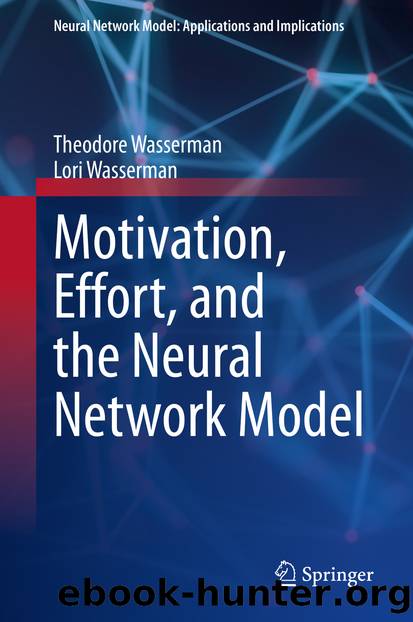Motivation, Effort, and the Neural Network Model by Theodore Wasserman & Lori Wasserman

Author:Theodore Wasserman & Lori Wasserman
Language: eng
Format: epub
ISBN: 9783030587246
Publisher: Springer International Publishing
6.2 The Dopamine Connection
Central to any model using neuroeconomics and computational modeling to explain complex human behavior is the science that demonstrates that dopamine cells report the error in predicting expected reward delivery. Specifically, recent neuroscience discoveries show a convergence between patterns of activity in the midbrain dopamine neurons and computational model of reinforcement learning (Schultz, Dayan, & Montague, 1997). Additionally, research has shown that dopamine might also be involved in the processing of types of intrinsic motivation associated with novelty and exploration (Horvitz, 2007). This is accomplished by dopamine-based responses that are interpreted as reporting âprediction errorâ in general and not only âreward prediction errorâ in specific. Taken together, these findings support the idea that intrinsic motivation systems are represented in the brain, in part, by signals representing prediction error (Oudeyer, Kaplan, & Hafner, 2007).
Dopamine neurons come in various types, each of which are connected with distinct brain networks and have distinct roles in motivational control. Some dopamine neurons encode motivational value, supporting brain networks for seeking, evaluation, and value learning. Others encode motivational salience, supporting brain networks for orienting, cognition, and general motivation. Both types of dopamine neurons are augmented by an alerting signal involved in rapid detection of potentially important sensory cues (Bromberg-Martin, Matsumoto, & Hikosaka, 2010).
A central tenet of these models is that discrepancies between actual and expected outcomes can be used for learning. These discrepancies have been termed prediction errors and neural correlates of such prediction-error signals have been observed now in midbrain dopaminergic neurons, striatum, amygdala and even prefrontal cortex. Models incorporating prediction errors have been invoked to explain complex phenomena such as the transition from goal directed to habitual behavior, all concepts critical to the understanding of motivation and goal seeking behavior (Niv & Schoenbaum, 2008).
Download
This site does not store any files on its server. We only index and link to content provided by other sites. Please contact the content providers to delete copyright contents if any and email us, we'll remove relevant links or contents immediately.
| Administration & Medicine Economics | Allied Health Professions |
| Basic Sciences | Dentistry |
| History | Medical Informatics |
| Medicine | Nursing |
| Pharmacology | Psychology |
| Research | Veterinary Medicine |
Periodization Training for Sports by Tudor Bompa(8175)
Why We Sleep: Unlocking the Power of Sleep and Dreams by Matthew Walker(6620)
Paper Towns by Green John(5094)
The Immortal Life of Henrietta Lacks by Rebecca Skloot(4529)
The Sports Rules Book by Human Kinetics(4304)
Dynamic Alignment Through Imagery by Eric Franklin(4125)
ACSM's Complete Guide to Fitness & Health by ACSM(3992)
Kaplan MCAT Organic Chemistry Review: Created for MCAT 2015 (Kaplan Test Prep) by Kaplan(3942)
Introduction to Kinesiology by Shirl J. Hoffman(3728)
Livewired by David Eagleman(3688)
The Death of the Heart by Elizabeth Bowen(3555)
The River of Consciousness by Oliver Sacks(3543)
Alchemy and Alchemists by C. J. S. Thompson(3453)
Bad Pharma by Ben Goldacre(3359)
Descartes' Error by Antonio Damasio(3232)
The Emperor of All Maladies: A Biography of Cancer by Siddhartha Mukherjee(3072)
The Gene: An Intimate History by Siddhartha Mukherjee(3050)
The Fate of Rome: Climate, Disease, and the End of an Empire (The Princeton History of the Ancient World) by Kyle Harper(3007)
Kaplan MCAT Behavioral Sciences Review: Created for MCAT 2015 (Kaplan Test Prep) by Kaplan(2941)
